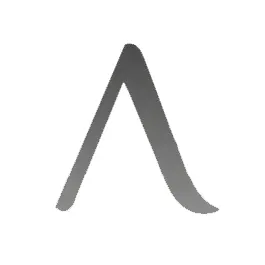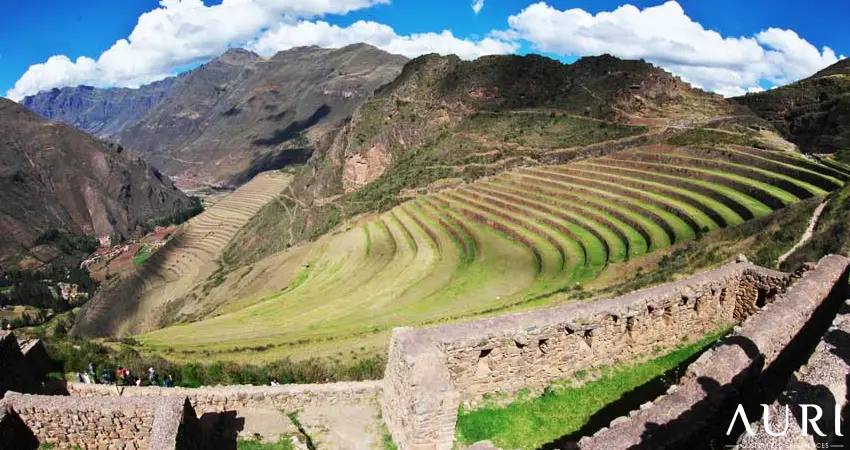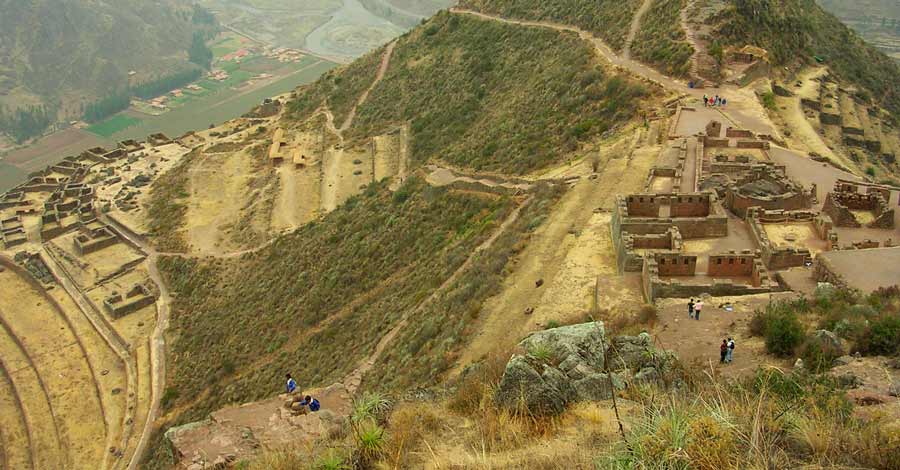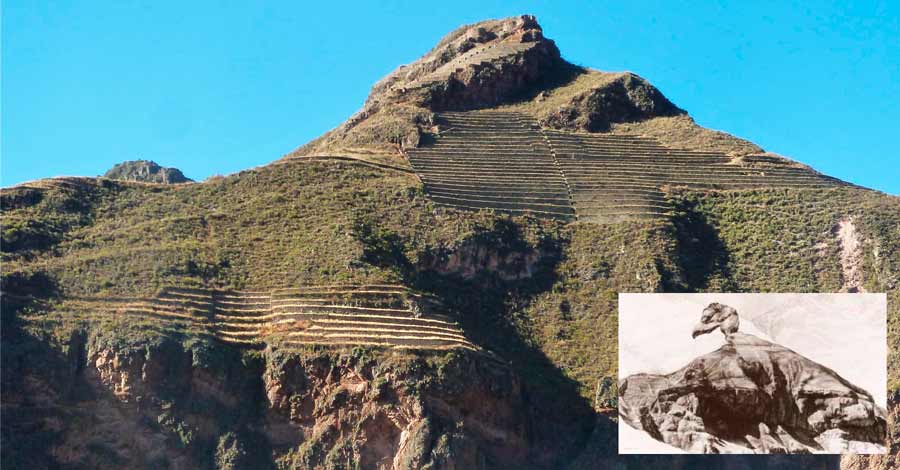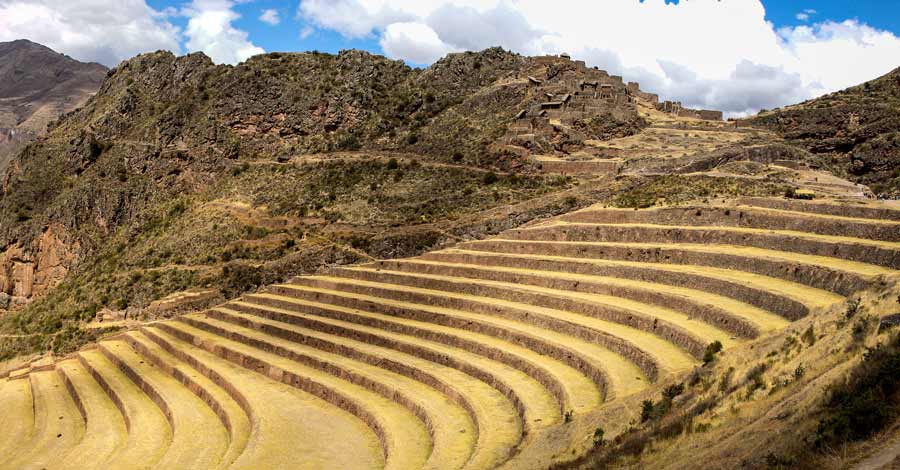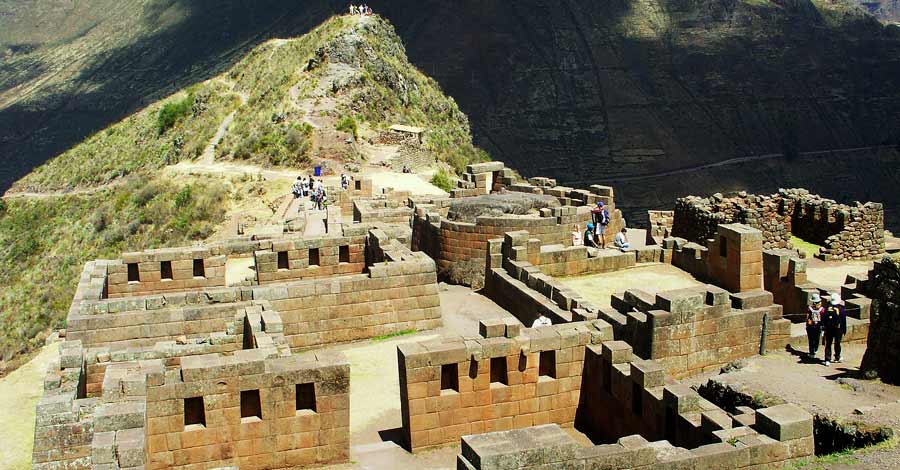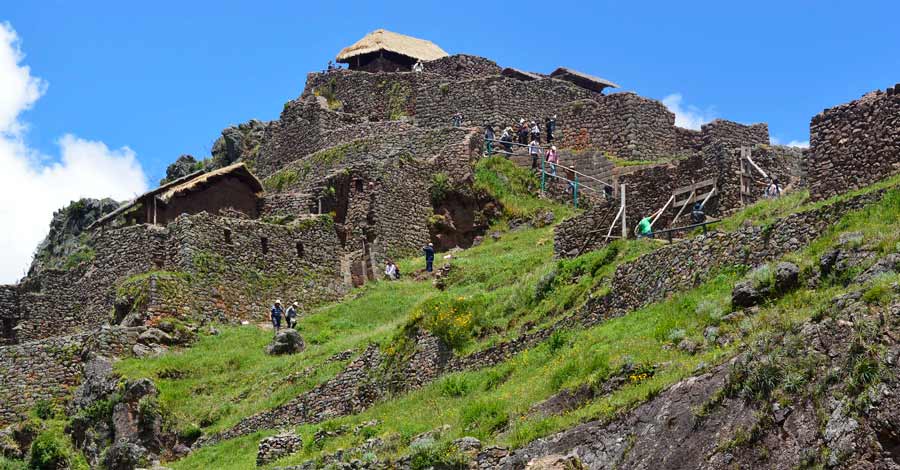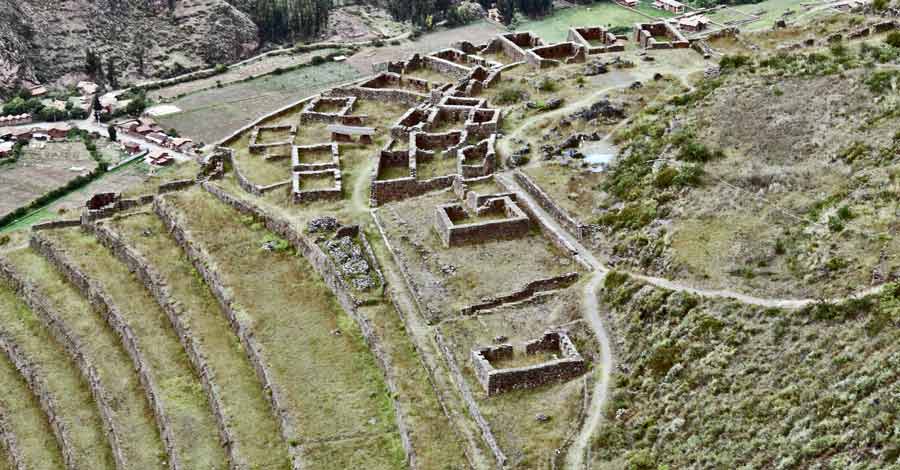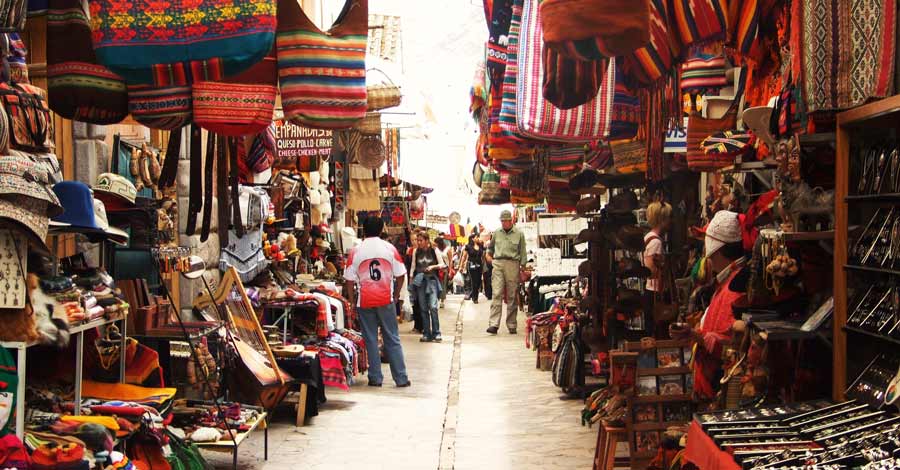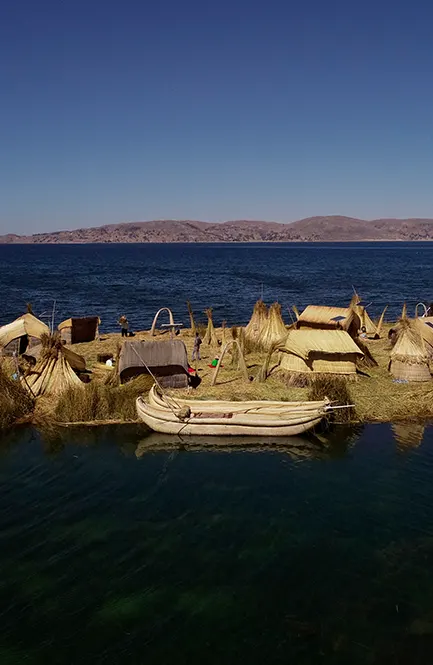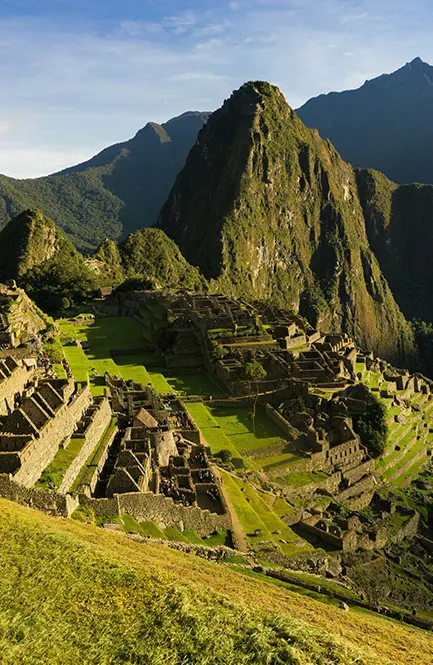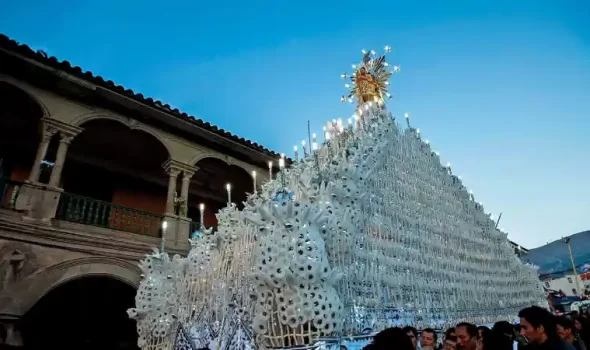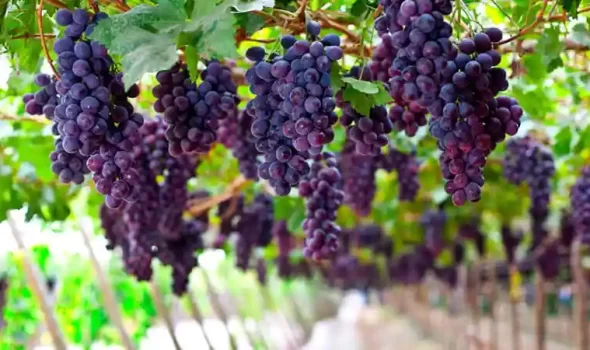Pisac is within the mountainous region of Cusco, an ancient land that has been blessed by its great historical legacy and scenic beauty. Throughout these Andean lands, among mountains, valleys, ravines, lagoons or the most beautiful and monumental Inca sites we find the Sacred Valley of the Incas. One of the most popular and must-see sites in the Sacred Valley is precisely Pisac, an Inca city built on the top of the mountains and many constructions defy the laws of modern engineering to be built on the edge of these mountains.
Discover the details of this great Inca metropolis with Auri Peru Travel, here we will tell you many facts that will surely be of your interest and that you should know before venturing into the Sacred Valley of the Incas.
What is Pisac (Pisaq)?
Pisac or Pisaq is a large Inca archaeological complex consisting of multiple archaeological units (today called neighborhoods), which extend along the top of the mountains and in many sectors on the ridge of these. Unlike Sacsayhuaman, which was severely destroyed to reuse its materials, Pisac still preserves buildings, complete walls, houses, food deposits, guard posts, and other constructions that are part of that great Inca legacy for humanity.
Where is Pisac?
If one wishes to arrive at Pisac, one should know that this great Inca complex is located about 32 kilometers from the city of Cusco, within the district of the same name that belongs to the province of Calca within the region of Cusco and at the top of the mountains of the eastern cordillera.
What is the altitude of Pisac?
The altitude occupied by Pisac rises from 3014 to 3504 m.a.s.l., due to a series of terraces that extend from the summit to the base of the mountain. Most of the archaeological sectors or “neighborhoods” are located above 3300 meters above sea level.
Weather in Pisac:
As mentioned above, Pisac is located between 3014 (village) and 3504 (Kallaqasa sector) meters altitude. The climate is generally more temperate compared to the city of Cusco. But it also has two well-defined seasons: dry season (May to October) and the rainy season (November to May). The average annual temperature varies between 12 to 24°C during the day, being colder at night. Both are conditioned to the season.
What does Pisac mean?
According to historian Victor Angles Vargas, “Pisaq” is a word that has no translation from Quechua, but derives from P’isaqa, a hen or bird now extinct that looked like a large partridge. According to the story, this bird could have lived in the mountains where the present archaeological complex is located.
The name Pisac would have come from the abundance of these birds in the sector and this would be confirmed by the morphology of an important sector or neighborhood of the Pisac complex, whose shape resembles that of a partridge when it is seen from the air.
A brief history of Pisac:
According to the ethnohistorical data of Waldemar Espinoza, until the time of Huiracocha, eighth Inca, the curacas or rulers who lived adjacent to Cusco, for the most part, were not subject to the Inca curacazgo or ethnicity, rather they lived in peace thanks to marriage alliances since ancient times. The Inca domain, whenever it could, extended one step at a time to distant nations over many leagues.
Huiracocha Inca, seduced by the power of the domination made a crude war to all the adjacent lordships. The pretext was the murmurings of these, who censured the way Huiracocha had come to power usurping it to his father, and of having altered the religion when ordering that the major cult would be for the god Wiracocha instead of the Sun and other gods. To impress, even more, the Inca himself took the name of Huiracocha. He subdued the totality of ayllus under his obedience.
The war began in the valley of Calca, four leagues from Cusco, and continued through other lordships of the Yucay valley to Urubamba. The territory of the current Sacred Valley would be a constant war zone until the rise of Pachacutec to power when he would finish subduing the ethnic groups that inhabited the valley. The name of the local ethnic group that inhabited the surroundings of Pisac was Cuyo, who after battling against Pachacutec would end up being subdued and integrated by force to the growing Inca domain.
Later, after the arrival of the Spaniards, Pisac would be invaded and plundered by them. The pre-Hispanic cemeteries would be desecrated because the burials used to be accompanied by the most precious possessions of the deceased along with offerings of gold, silver, precious stones and others.
Pisac would also be the victim of the crossfire during the rebellion of Manco Inca and the constant fights that were unleashed in the valley of Yucay. Once Manco Inca’s rebellion was defeated and through the so-called “Indian Reductions”, the viceroy Toledo would force and concentrate the indigenous populations scattered throughout the area in one place, in the area around the Inca site of Pisac, in what is now the current town of Pisac, on the right bank of the Urubamba River.
Who built Pisac?
The construction of Pisac Archaeological Park is attributed to the ninth Inca, Pachacutec, during the 15th century. Pisac along with many Inca monumental constructions are attributed to this Inca and some people even attribute Pisac to have served as Pachacutec’s country house or palace.
Pisac, ritual space of the Andean condor in the Sacred Valley?
Some authors affirm that one of the slopes of Pisac resembles the shape of an Andean condor. This would derive from the fact that during Inca time, it was believed that the condor (vultur gryphus), the second largest non-marine bird on the planet, was the messenger of the sun and its mission was to carry the spirits of the deceased to the outside world. Therefore, the theory states that it would not be surprising that this condor-shaped hillside is located between two pre-Hispanic cemeteries found in the area. This theory is, of course, merely speculative, but it is still quite curious.
What was the function of Pisac?
For its great territorial extension, some authors like Victor Angles Vargas, catalog Pisac as a great Inca metropolis. For other authors it was a property or “country house” of the Inca Pachacutec. However, everything points to the fact that Pisac was a multifunctional Inca center in the sacred valley of the Incas, due to the different sectors with multifunctional uses. Everything points to the fact that it fulfilled administrative, religious, agricultural, ceremonial and astronomical functions.
The Inca terraces of Pisac:
In the eastern part of Pisac, there lies one of the most impressive works of Inca agricultural engineering, the agricultural terraces commonly known as “Andenes” or Inca terraces. The agricultural terraces are cultivation surfaces leveled staggered on the slopes of the mountains through retaining walls and retention.
In the case of Pisac, there are different sectors covered with Inca terraces, one of these sectors is called Ajchapata terraces (40 terraces that together have triangular shape). These cover the entire slope between the hills of Intiwatana and Linliy to the depths of the valley. And, if we take as a reference the current square of the town of Pisac, we will notice that the Inca terraces begin only 200 meters from it. According to Victor Angles Vargas, their function was not only agricultural but also aesthetic-religious.
The neighborhoods or sectors of Pisac:
Intiwatana neighborhood:
It is the central neighborhood, home to temples and palaces with higher architectural quality. Its enclosures are larger compared to other neighborhoods. In this neighborhood, we find waywas and suqanqas (Inca implements for astronomical observation). Also, here is the Intiwatana, a megalithic monument that fulfilled functions of time measurement to optimize agriculture.
In the neighborhood, we also find a ceremonial ushnu, an altar carved in volcanic breccia and small liturgical fountains. It should be noted that the entire neighborhood was fenced.
Tianayuc neighborhood:
It is located a short distance from the previous neighborhood, this is characterized by being a small neighborhood whose rooms overlook a central courtyard. It has a tower that dominates the nearby ravine.
Kallaqasa neighborhood:
It is the neighborhood that is located at the highest altitude and the most extensive. It has many rooms, steep slopes, towers, courtyards, a tunnel of 3 meters and has ravines. The place has rustic architecture, which suggests that was occupied since pre-Inca times and reconditioned by the Incas.
Pisaqa neighborhood:
It consists of 23 enclosures built under an amazing aesthetic order, although the enclosures are of lower quality compared to the neighborhood of Intiwatana. It has walls of the imperial Inca style perfectly assembled together. Towards the southeastern side of the neighborhood a wide slope descends that was used for the construction of platforms to the bottom of the valley. This is the sector whose shape resembles a partridge, if it is viewed from the air.
Qanchisraqay or Qanturaqay neighborhood:
It has many medium and small constructions, edged and with mud mortar. There are a total of 18 enclosures, 25 uncovered areas and 5 agricultural terraces or platforms. This sector could have been a ceremonial center of totemic form and whose architectural plant resembles the head of a condor if seen from the air, so many call it “Kuntur Raqay” (condor’s head).
Other sectors of Pisac:
Torreones or Pukaras:
Pisac can well be called the Inca llaqta (town) of the towers, because there are more than twenty of them. According to Victor Angles Vargas, there are two types, habitat towers and watchtowers. The first are semicircular cone-shaped enclosures associated with water channels for human consumption.The atalaya towers are not enclosures, they are of solid texture and its interior is compact, they were installed for oral communication and by signs.
The Inca cemetery:
It is located at the eastern end of the mountain called Linle, in front of the Kallaqasa sector and separated by the Kitamayu stream. This cemetery has pre-Inca origins and is known as Tantanamarca (place of lamentations). Victor Angles Vargas suggests that the high area of the site, a cliff, could also have served as a scaffold where the condemned were thrown to death. It is estimated that there are about 2500 tombs, unfortunately, all were looted by Spaniards upon their arrival in the sixteenth century.
The actual town of Pisac
Nowadays there are two Pisac in the sacred valley of the Incas: the Inca Pisac at the top of the mountains, and the town of Pisac, the current town of colonial origin product of the Indian reductions at the time of Viceroy Toledo. The town is located at an altitude of 2,972 meters above sea level, in the middle of the sacred valley. The town is mainly dedicated to agriculture, livestock, handicrafts, tourism and trade.
The Pisac market
Currently, the town square of Pisac houses a colorful handicraft market where you can find everything from fresh fruits to the most colorful handicrafts. The place gathers people from the town, as well as from nearby communities; here we can find different types of looms, chullos, bags, alpaca garments, jewelry, musical instruments, paintings, key chains and an endless number of products characteristic of the region.
How to get to Pisac?
Pisac (the village) is located about 45 minutes by car from the city of Cusco, within the Sacred Valley of the Incas. To access the archaeological site, it takes about 15 minutes more.
Traveling on your own:
One of the options is to start from Puputi Street (15 minutes from the Cusco city center) or from Tullumayu Street. At these points we find buses and minivans heading to the town of Pisac, emphasizing that the arrival time is longer because this is public transport. Prices vary between 8 and 12 soles. If you want more comfort, you can hire private transportation, obviously the cost is significantly higher.
Travel with a travel agency:
This option is more practical for those who have less time to visit Pisac and other archaeological sites located in the Sacred Valley.Almost all agencies include transportation (to the archaeological sites) and guided tours. It is important to emphasize that you must use the services of a formal agency that has the permits granted by the corresponding authorities. The tour that includes the visit to Pisac varies in duration according to the archaeological sites to be visited.
Pisac Schedule:
Tourist activities occur during uninterrupted hours from 6 am to 6 pm.
Entrance ticket price to Pisac :
Pisac is part of the tourist circuit of the Sacred Valley along with other archaeological sites, you can access the place by acquiring the “Cusco tourist ticket” (Boleto Turístico), whether it is the partial ticket or the integral ticket.
Peru has many incredible places to discover. With many years of working in the travel industry, Auri Travel is happy to help with your travel plans to Machu Picchu and other places around the country. Our experts travel designers are well-prepared to solve any doubt that you may have to organize a trip for a lifetime! Come and enjoy your Peruvian Adventure with us!
